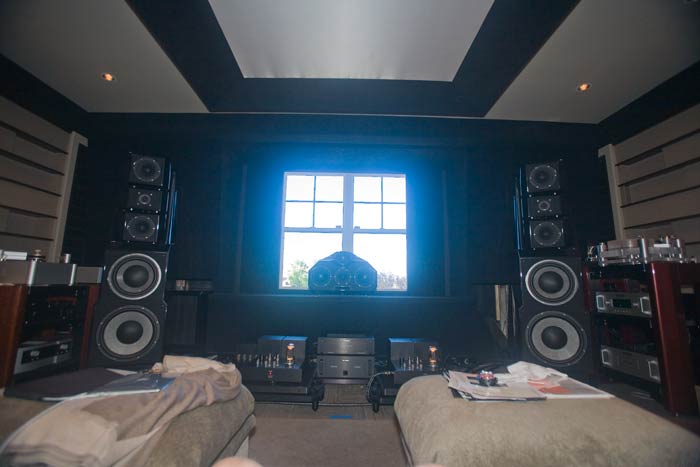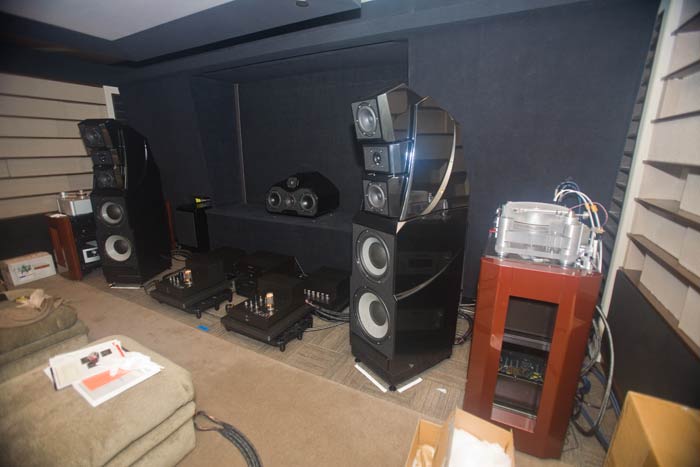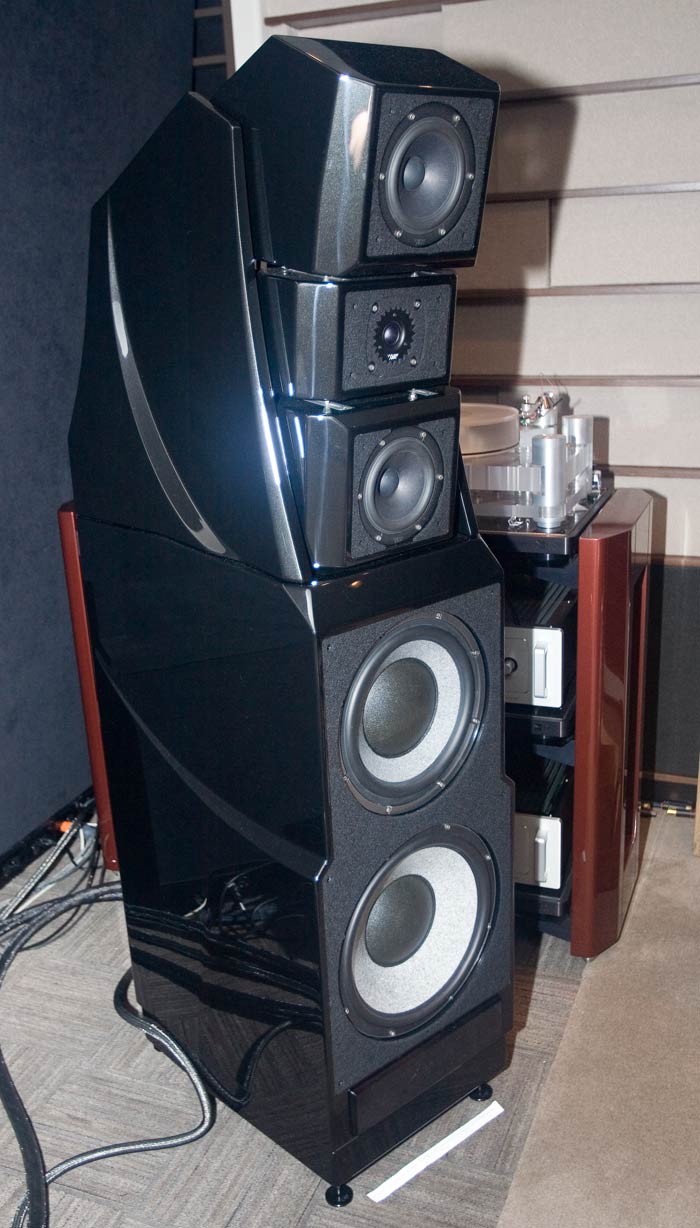Wilson Alexandria XLF speakers
We got a chance to hear the Wilson Alexandria XLF speakers last week.

We listened to them in a nearfield position, I would say about 7 feet from the plane of the loudspeakers.
We heard them with Audio Research 750ish [:-)] amps, Lamm ML3 amps, Audio Research Reference Anniversary preamp, Lamm L2 preamp, Tara Labs The Zero Gold interconnects and speaker cables, Nordost Odin interconnects and speaker cables. Tara Labs Cobalt power cords and Nordost Odin power cords.
Source was a Basis Inspiration with their Vector arm and a Lyra Atlas. Phonostage from Ypsilon, with external stepup transformer. Everything was on HRS M3X platforms and MXR equipment rack.

Because we never heard the system in an entirely familiar configuration [there were always Tara Labs interconnects in the signal] and because we listened in quite a nearfield position to such large speakers, we cannot do an exact comparison with the previous model: the Alexandra X2 [2nd update] speakers.
But we can say a little something…

First, listening nearfield to such imposing speakers went quite well. The only issue, for me, was that the highs were always coming from the top of the soundstage and the lows from the bottom. Sitting farther away would help merge the two frequency extremes.
Second, the speakers do sound more integrated and the cabinet also more rigid – the only overt cabinet issue to my ears was that the bass frequencies tended to be drawn to the speakers [mostly noticeable only when sitting quite a bit off center from the sweet spot]. [the previous model had a preponderance of softness extending down from the midrange which sounded like the cabinet was robbing the sound of a lot of its energy – typical of speakers not perfectly rigid. For example compare the sound of aluminum speakers to ordinary speakers – with everything else being equal the aluminum speakers will have more energy and the midbass frequencies will be less likely to seemingly originate from the cabinet ]
The speakers do respond well to changes in upstream components which means one really can tailor the sound to one’s sonic preferences to a large degree.
It was a real kick listening to these this way – with the drivers exposed and staring us down it was like listening to really, really large monitors – or like a wall of speakers at a concert.
The Lamm ML3 amps are able to drive these speakers to louder-than-you-want-to-listen-to volumes without any apparent strain to any of our ears [and we were listening closely for any sign of weakness or hesitancy. This would be a fun test late at night :-)].
The speakers were back ported in this room and, although that is a little strange for such a small room with the speakers along the long wall, the speakers did not sound at all to us like they needed to be setup any differently [most listening rooms we see often need the speakers to be re-positioned to sound their best.]
Listening to the Alexandria XLF nearfield like this was a blast, but after listening to our system here (Lamm ML2.1 amps on Marten Coltrane Supreme speakers) in a similar nearfield position, and recalling other Wilson Alexandria systems, the Wilsons do sound their best in a larger room (if possible!).
I would say the XLF is an evolutionary upgrade, as opposed to revolutionary – but at this level, every last little improvement to the sound will be appreciated by avid listeners – so if you are a Wilson owner with the rest of your system such a configuration that you are [at least for the moment :-)] happy with it , you should by all means go for the XLF.

While I may be misinformed, I do not believe that existing Alexandria’s can be updated. In fact the used price on the X-2 has dropped on the used market to about $50K. There appears to be a lot of dumping going on. Your experiences are very similar to mine with respect to room size. For large multi-driver systems to integrate, you need to have a large enough room to get some distance between them and the listening position. Did yo actually form any opinion with respect to the sound of the Tara Labs vs. the Odin? How about with respect to the Atlas cartridge or the Ypsilon phono? I realize that this would be a stretch as isolating one element, particularly when you cannot switch to a known like the Brinkman/ AN combination is probably impossible, but fun to speculate. Also when are you going to post the systems which you are taking to RMAF?
Hi Fred!
Well, then, replace ‘upgrade’ with sell-and-replace. – which makes it even more relevant that one makes sure one’s system is fully where one wants it to be before spending the $$$ for the XLF [although some places have a good trade-in program]. Hmmmm, I see the old undamaged X2’s listed for around $70K.
As far as nearfield goes, the cabinet design of the Kharma and Marten make them pretty decent nearfield.
The Tara Labs speaker cable [we did a back-to-back comparison] was primarily more ‘compressed sounding’ [across all dynamics, from micro- to macro-] than the Odin, and so brought all the benefits and problems of that to the sound [I am of the belief that some people prefer a compressed sound]. The Tara Labs did NOT affect the tonality/timbre to any great degree – which was great… and kind of a pleasant surprise – as I have come to suspect many top-line cables pervert harmonics, as do some large and quite popular amps, surprisingly enough.
No, couldn’t tell much about the front end. We did accumulate some evidence, however, that the Loricraft record cleaner cleans better than the Clearaudio record cleaner.
We are not showing at RMAF this year. We had shown for all 7? years previously but the last 2 years, since we lost our large room have not been fun nor profitable -and no one can find us anymore as we keep having to move around from year to year. 2 years ago the room had a 60-65dB background noise [we measured] from the coke machine out in the hallway and last year we had d’Agostino playing LOUD disco and techo across the hall with their door propped open the whole show – opera with a techno beat just doesn’t work so well.
I am still planning on taking some photos – so we’ll see.
Take care,
-Mike
Hi Mike,
Can you do your best to explain and describe what you mean by the term “compressed sound”?
(How I wish my home is situated next to your showroom!)
Thanks so much,
Joseph
Hi Joseph,
Traditionally compressed sound is described in terms of the lack of dynamics – that the SPL between the loudest and softest notes is less than what it should be.
I think of it, visually, as when the bar graph of the music for a song, say, [there is a popular site that shows the graph for each song – but I forget what it is called], is squished so that the chart looks like hills instead of mountains.
I think of it soundwise, as music where every note is not quite as distinct and proud as it ought to be – causing it to sound dull and lifeless. It often leaves one with the desire to want to turn up the volume. Conversely, compressed treble can often sound hard and even biting upon the poor eardrums, making one want to turn the volume down. This mental frustration of wanting, always wanting, to change the volume in two different directions often results in one picking a different music selection … or turning off the system entirely.
Hope this helps,
Take care,
-Mike
Many thanks Mike for your helpful and informative reply. There are a bunch of other terms that leave me scratching my head e.g. midrange suckout, flat frequency response, flat timbre, harmonics etc. I mean I know what those words mean but I won’t know if I’m hearing them in a particular recording or in a component.
But at least I now have a better idea of whether I’m listening to compressed music or not
Thanks again,
Joseph